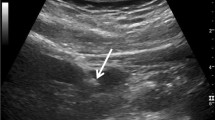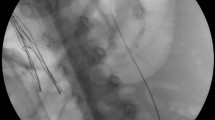Abstract
Background
Percutaneous ultrasound-guided biopsy is performed in paediatric patients for evaluation of diffuse renal parenchymal disease. When compared with the non-coaxial technique, the coaxial technique has the advantages of obtaining multiple tissue cores via a single capsular puncture and post-biopsy tract embolisation.
Objectives
To compare the coaxial and non-coaxial techniques of percutaneous ultrasound (US)-guided biopsy of native kidney parenchyma in children and adolescents with renal disease.
Materials and methods
We retrospectively identified consecutive patients who underwent percutaneous US-guided renal biopsy using an 18-gauge core biopsy needle from July 2019 to July 2021 in a single tertiary paediatric nephrology centre. Focal renal tumour biopsy and transplant kidney biopsy were excluded. The total glomerular yield, specimen adequacy, complication rate and procedural time between the coaxial and non-coaxial groups were compared.
Results
There were 34 percutaneous US-guided renal biopsies: 22 using a coaxial technique and 12 using a non-coaxial technique. The total median glomerular yield obtained was higher in the coaxial group (coaxial=37.9; non-coaxial=22.2; P=0.02). No statistically significant difference was noted between specimen adequacy (coaxial=100%; non-coaxial=91.7%; P=0.35). While no statistically significant difference was detected for overall complication rates (coaxial=13.6%; non-coaxial=41.7%; P=0.09), the coaxial group had a lower rate of haemorrhagic complications (coaxial=4.5%; non-coaxial=41.7%; P=0.01). One patient in the non-coaxial group had post-biopsy haemorrhage requiring embolisation. The procedural time was shorter in the coaxial group (coaxial=26.3 ± 7.0 min; non-coaxial=51.3 ± 11.5 min; P<0.001).
Conclusion
Percutaneous US-guided renal biopsy in children using the coaxial technique has significantly higher total glomerular yield, shorter procedural time and fewer haemorrhagic complications, compared to biopsies using the non-coaxial technique.



Similar content being viewed by others
References
Towbin RB, Baskin K (2015) Pediatric interventional radiology. Cambridge University Press, Cambridge
Sheth RA, Baerlocher MO, Connolly BL et al (2020) Society of Interventional Radiology quality improvement standards on percutaneous needle biopsy in adult and pediatric patients. J Vasc Interv Radiol 31:1840–1848
Furness PN (2000) ACP Best practice no 160. Renal biopsy specimens. J Clin Pathol 53:433–438
Hatfield MK, Beres RA, Sane SS et al (2008) Percutaneous imaging-guided solid organ core needle biopsy: coaxial versus noncoaxial method. AJR Am J Roentgenol 190:413–417
McDonald J, Amirabadi A, Farhat Z et al (2019) Experience with compressed gelfoam plugs in children during liver biopsies and other IR procedures: a retrospective single-center case series. J Vasc Interv Radiol 30:1855–1862
Babaei Jandaghi A, Lebady M, Zamani AA et al (2017) A randomised clinical trial to compare coaxial and noncoaxial techniques in percutaneous core needle biopsy of renal parenchyma. Cardiovasc Intervent Radiol 40:106–111
Uppot RN, Harisinghani MG, Gervais DA (2010) Imaging-guided percutaneous renal biopsy: rationale and approach. AJR Am J Roentgenol 194:1443–1449
Fotiadis N, De Paepe KN, Bonne L et al (2020) Comparison of a coaxial versus non-coaxial liver biopsy technique in an oncological setting: diagnostic yield, complications and seeding risk. Eur Radiol 30:6702–6708
Robbins KA, Keet CA (2015) Intraoperative anaphylaxis likely due to Gelfoam in a pediatric patient undergoing liver biopsy. Ann Allergy Asthma Immunol 114:531–533
Mai J, Yong J, Dixson H et al (2013) Is bigger better? A retrospective analysis of native renal biopsies with 16 gauge versus 18 gauge automatic needles. Nephrol (Carlton) 18:525–530
Author information
Authors and Affiliations
Corresponding author
Ethics declarations
Conflicts of Interest
None
Additional information
Publisher’s note
Springer Nature remains neutral with regard to jurisdictional claims in published maps and institutional affiliations.
Rights and permissions
About this article
Cite this article
Fung, K.F.K., Cheng, K.K., Chan, E.YH. et al. Percutaneous ultrasound-guided renal biopsies in a paediatric population: comparison of coaxial and non-coaxial techniques using 18-gauge core biopsy needles. Pediatr Radiol 52, 2431–2437 (2022). https://doi.org/10.1007/s00247-022-05359-x
Received:
Revised:
Accepted:
Published:
Issue Date:
DOI: https://doi.org/10.1007/s00247-022-05359-x




